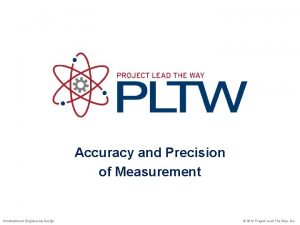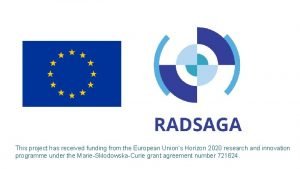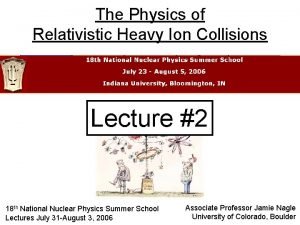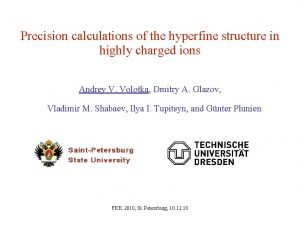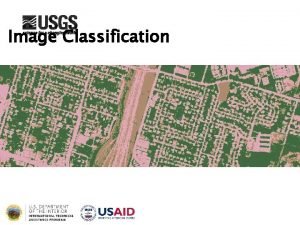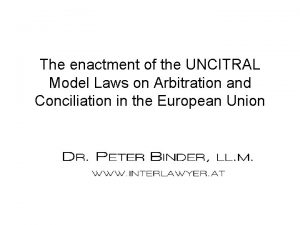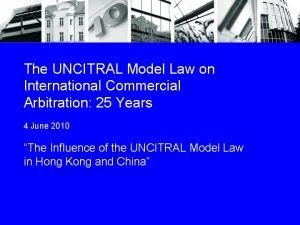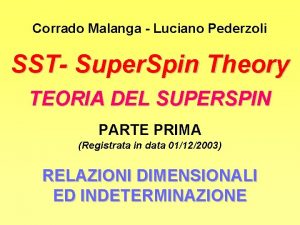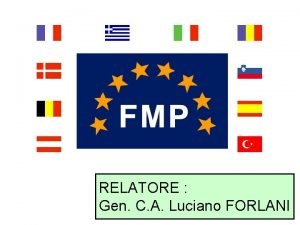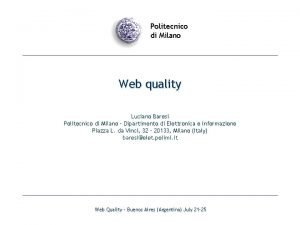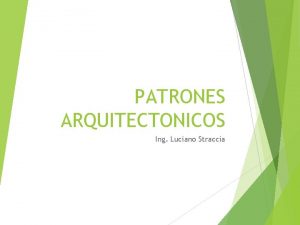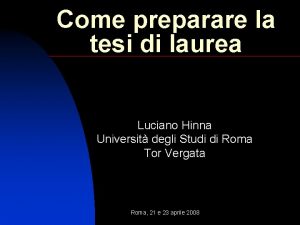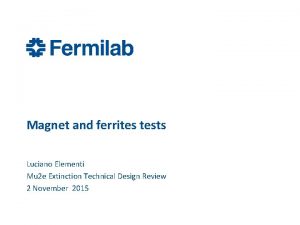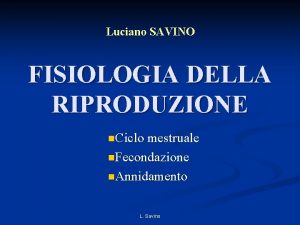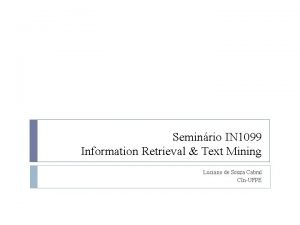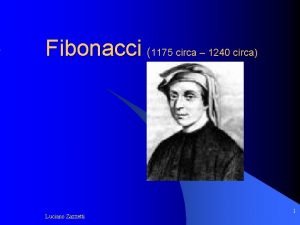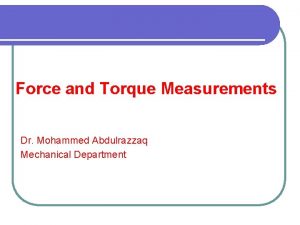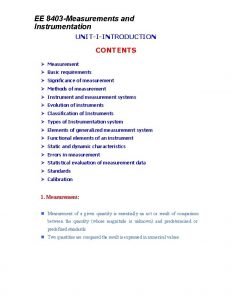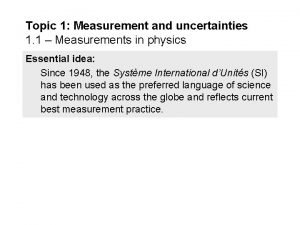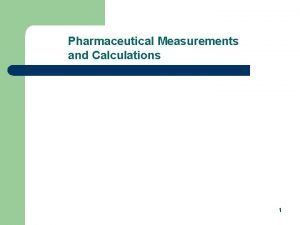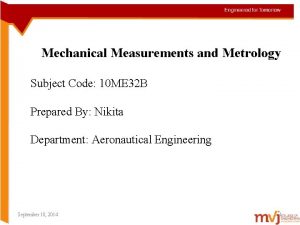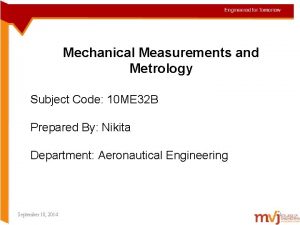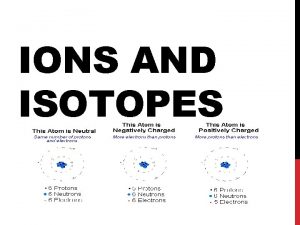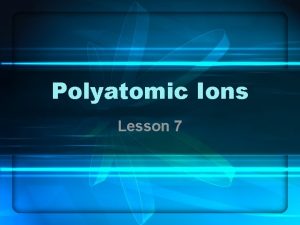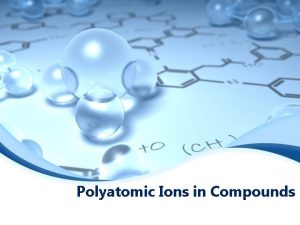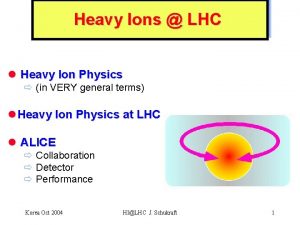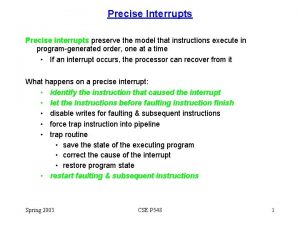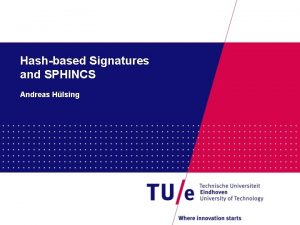Heavy Ions Signatures and precise measurements Luciano Ramello























































- Slides: 55

Heavy Ions: Signatures and precise measurements Luciano Ramello, Università del Piemonte Orientale and INFN sez. Torino, Alessandria, Italy

Outline • Heavy Ion experiments at the LHC • Global properties • Particle production • Collective effects • Jet quenching • Open heavy flavours • Quarkonia • Summary & Outlook Luciano Ramello Physics in Collisions 2016 – Quy Nhon, Vietnam 2

Heavy Ion Collisions at the LHC Hard processes (heavy flavours, jets, direct photons): probe the whole evolution of the system Luciano Ramello Soft processes (bulk particle production, correlations): decouple late, indirect signals of QGP • Particle composition fixed at Tch ≈ 160 Me. V • Momentum spectra fixed at Tfo ≈ 110 -130 Me. V Physics in Collisions 2016 – Quy Nhon, Vietnam 3

Heavy Ion Experiments at CERN LHCb joined since the p-Pb run of 2013 Luciano Ramello Physics in Collisions 2016 – Quy Nhon, Vietnam 4

LHC Run 1 and Run 2 Run 1 Colliding System Run 2 Year(s) Pb-Pb 2. 76 Te. V 2010, 2011 5. 02 Te. V 2015* Quark Gluon Plasma study p-Pb 5. 02 Te. V 2013* 5. 02 Te. V 8 Te. V 2016** (upcoming) Cold Nuclear Matter effects, Reference for Pb-Pb pp 2. 76 Tev 7 Te. V 8 Te. V 2011, 2012 5. 02 Te. V 13 Te. V 2015, 2016 Reference for p-Pb and Pb-Pb; 13 Te. V: onset of collectivity? * First time for LHCb in Heavy-Ion collisions: p-Pb 2013, Pb-Pb 2015 ** November-December 2016 Luciano Ramello Physics in Collisions 2016 – Quy Nhon, Vietnam 5

Centrality determination ALICE: Phys. Rev. C 88, 044909 (2013) VZERO (scint. hodoscope) amplitude determine centrality percentiles from 0% (most central) to 90% Centrality characterized by impact parameter b, number of nucleon participants Npart, number of N-N collisions Ncoll • related to observables like multiplicity, transverse energy via Glauber model Luciano Ramello Physics in Collisions 2016 – Quy Nhon, Vietnam ATLAS: PLB 707 (2012) 330 6

Charged particle multiplicity PRL 116 (2016) 222302 Luciano Ramello Physics in Collisions 2016 – Quy Nhon, Vietnam 7

Centrality dependence of d. Nch/d at midrapidity • Npart from Glauber model • Similar evolution with centrality between 2. 76 and 5. 02 Te. V • 20% increase going from 2. 76 to 5. 02 Te. V PRL 116 (2016) 222302 Luciano Ramello Physics in Collisions 2016 – Quy Nhon, Vietnam 8

Bulk particle production in central Pb-Pb Blast-wave fits to extract: • kinetic freeze-out temperature • radial flow velocity Tkin ~ 95 Me. V (similar to RHIC) < T> ~ 0. 65 (10% larger than at RHIC) larger radial flow than at RHIC Spectra become harder with increasing centrality (from peripheral to central) and more so for heavier particles, as expected by collective expansion (see backup slides for details) ALICE: PRC 88, 044910 (2013) Luciano Ramello Physics in Collisions 2016 – Quy Nhon, Vietnam 9

Bulk particle production in p-Pb A combined BW fit describes spectra fairly well also in p-Pb The Tkin - < T> correlation shows similar trends for pp and p-Pb ALICE p-Pb and Pb-Pb: PLB 728 (2014) 25 (hyperons excepted) Luciano Ramello Qualitatively PYTHIA with Color Reconnection shows a similar trend as the data: other final state mechanisms can mimic the effect of radial flow Physics in Collisions 2016 – Quy Nhon, Vietnam 10

Strangeness enhancement a historical probe for QGP formation Rafelski and Müller, PRL 48, 106 (1982) Rafelski and Hagedorn, in Statistical Mechanics of Quarks and Hadrons ALICE, PLB 728 (2014) 216 corrigendum: PLB 734 (2014) 409 Luciano Ramello Physics in Collisions 2016 – Quy Nhon, Vietnam 11

Strangeness from pp to p-Pb to Pb-Pb ALICE: PLB 758 (2016) 389 In high multiplicity p-Pb at 5. 02 Te. V: • Ξ/π compatible with central Pb-Pb • Ω/π compatible with 60 -80% Pb-Pb Also in high multiplicity pp multi-strange production rises significantly • PYTHIA 8 does not reproduce the values nor the trend of the data • MC models as DIPSY (color ropes) and EPOS LHC exhibit a trend with multiplicity but may still need tuning Luciano Ramello Physics in Collisions 2016 – Quy Nhon, Vietnam 12

Particle yields and Thermal models Luciano Ramello Physics in Collisions 2016 – Quy Nhon, Vietnam 13

Collective expansion: Anisotropic flow • Basic idea: space anisotropy of initial fireball momentum anisotropy in final hadron distributions directed flow coeff. v 1 Reaction plane xz elliptic flow coeff. v 2 Several methods to extract vn: event plane, cumulants… … each with different systematics from ‘non-flow’ Luciano Ramello Physics in Collisions 2016 – Quy Nhon, Vietnam Figures courtesy F. Prino 14

Elliptic flow vs. centrality • Strong collective flow observed at LHC • Integrated values of elliptic flow coefficient v 2 sensitive to the p. T range, since v 2 increases (initially) linearly with p. T ATLAS, EPJC 74 (2014) 2982 Luciano Ramello Physics in Collisions 2016 – Quy Nhon, Vietnam 15

Elliptic flow vs. p. T • Moderate increase of v 2(p. T) at low p. T from highest RHIC energy to LHC energy, for a large increase in c. m. energy • The integrated v 2, thanks to a harder p. T distribution at higher c. m. energy, increases of 20 -30% from RHIC to LHC 20 -30% CMS: PRC 87, 014902 (2013) Luciano Ramello Physics in Collisions 2016 – Quy Nhon, Vietnam 16

Elliptic flow in Pb-Pb: 5. 02 Te. V compared to 2. 76 • Anisotropic flow coefficients v 2, v 3, v 4 integrated over p. T range 0. 2 -5. 0 Ge. V/c as a function of centrality • Average increase of (3. 0± 0. 6)% for v 2, (4. 3± 1. 4)% for v 3 and (10. 2± 3. 8)% for v 4 from 2. 76 to 5. 02 Te. V • Results compatible with predictions from hydrodynamic models, ratio viscosity/entropy density /s can be constrained by data ALICE: PRL 116 (2016) 132302 Luciano Ramello Physics in Collisions 2016 – Quy Nhon, Vietnam 17

The ridge(s) in two-particle correlation • Unexpected collective behaviour in high-multiplicity events at low p. T even in the small p-Pb system • Described either by colour glass condensate (initial state) or hydrodynamics (final state) Luciano Ramello Physics in Collisions 2016 – Quy Nhon, Vietnam ALICE, PLB 719 (2013) 29; See also: ATLAS PRL 110 (2013) 182302, CMS PLB 718 (2012) 795, LHCb ar. Xiv: 1512. 00439 18

The ridge in pp and p-Pb collisions pp ATLAS, PRL 116, 172301 (2016) See also: ATLAS-CONF-2016 -026 pp scaled by 1. 51 & p-Pb • pp collisions: no energy dependence observed between 2. 76 and 13 Te. V • Similar shapes (but not magnitudes) of v 2(p. T) in pp and p-Pb collisions • In p-Pb, v 2 (also v 3, v 4) increases with multiplicity Luciano Ramello Physics in Collisions 2016 – Quy Nhon, Vietnam 19

More on the ridge in p-Pb LHCb, ar. Xiv: 1512. 00439 • Yield integrated over pseudorapidity in the range 2. 0 -2. 9 as a function of • 1. 0 < p. T < 2. 0 Ge. V/c (where near-side ridge is most pronounced) • Five activity (multiplicity in preudorapidity range 2. 0 -4. 9) bins compared in p-Pb and Pbp • Correlation structures in the near and away side are compatible in both samples and grow stronger with increasing activity Luciano Ramello Physics in Collisions 2016 – Quy Nhon, Vietnam 20

Hard Probes in HI collisions • Hard probes (vector bosons, direct photons, heavy flavours, jets) produced early in HI collisions, with production cross-section unmodified wrt pp collisions (p. QCD) • Yields expected to scale with number of NN collisions, Ncoll • Typical observable: nuclear modification factor RAA (also Rp. A) • extract info on nuclear PDFs from p. A collisions and on medium properties (transport coefficients) from AA collisions Yield in AA pp reference Luciano Ramello Physics in Collisions 2016 – Quy Nhon, Vietnam 21

High p. T hadrons in Pb-Pb • Strong suppression in central Pb-Pb collisions wrt pp collisions • Nice agreement among the three experiments at 2. 76 Te. V • Similar suppression between 2. 76 and 5. 02 Te. V • does not necessarily imply same medium temperature at both energies CMS 5. 02 Te. V (prelim. ): CMS-HIN-15 -015 CMS 2. 76 Te. V: EPJC 72 (2012) 1945 ATLAS 2. 76 Te. V: JHEP 09 (2015) 050 ALICE 2. 76 Te. V: PLB 720 (2013) 52 Luciano Ramello Physics in Collisions 2016 – Quy Nhon, Vietnam 22

High p. T hadrons in p-Pb ATLAS, ar. Xiv: 1605. 06436 Rp. Pb vs. p. T for |y*|<0. 5 in p-Pb: • peak at about 3 Ge. V, flat behaviour above 8 Ge. V, also in 8 centrality classes (not shown here) • peak magnitude depends on rapidity and centrality Cold nuclear matter effect negligible above 8 Ge. V (relevant for Pb-Pb results in previous slide) Luciano Ramello Physics in Collisions 2016 – Quy Nhon, Vietnam 23

Single Jets in Pb-Pb ATLAS: PRL 114 (2015) 072302 Mid-peripheral collisions • The single jet nuclear modification factor shows no p. T dependence • Also it is flat in rapidity, despite changing spectral shapes and quark fraction in jets • it will be interesting to see the result at 5. 02 Te. V • RAA is well described by models Luciano Ramello Physics in Collisions 2016 – Quy Nhon, Vietnam Central collisions ALICE: PLB 746 (2015) 1 24

Di-Jet Asymmetry in Pb-Pb CMS-HIN-16 -005 CMS: PRC 84 (2011) 024906 Direct observation of jet quenching in Pb-Pb collisions at 2. 76 Te. V: dijet less balanced in central Pb-Pb collisions due to energy loss in the medium Luciano Ramello Dijet less balanced in central Pb-Pb collisions also at 5. 02 Te. V, effect less pronounced than at 2. 76 Te. V (different underlying parton spectrum) Physics in Collisions 2016 – Quy Nhon, Vietnam 25

More on di-jets ATLAS-CONF-2015 -052 ATLAS has unfolded the dijet asymmetry observable x. J: its distributions are shown for different selections on the leading jet p. T • for pp collisions • for 0 -10% most central Pb-Pb collisions The modifications observed in central Pb-Pb collisions lessen with increasing leading jet p. T, above 200 Ge. V/c (bottom-right panel) the maximum at x. J=1 is restored Luciano Ramello Physics in Collisions 2016 – Quy Nhon, Vietnam 26

Open heavy flavour production at the LHC • Heavy quarks (c, b) produced in initial high-Q 2 scattering process • calculable with p. QCD, actually bulk of HF production in pp collisions well described by p. QCD models • differential measurements of HF production provide strong constraints to models e. g. about MPI (multi-partonic interactions), collectivity in small systems • Measurements in p-Pb collisions provide information on the Cold Nuclear Matter (CMN) effects • Measurements in Pb-Pb collisions address heavy-quark energy loss mechanisms in the QGP: • colour-charge and mass dependence of parton energy loss • do c and b quarks participate in the collective expansion? Luciano Ramello Physics in Collisions 2016 – Quy Nhon, Vietnam 27

• Heavy quarks produced in initial hard scattering, experience full system evolution • the number of HQ is conserved unique tool to characterize the medium • at LHC HQ are produced copiously precision measurements • Partons lose energy by: • medium-induced gluon radiation • elastic collisions with other partons • Energy loss E in the medium depends on: • medium properties (transport coefficients ) • parton properties (mass*, colour charge) • path length L Expectation from radiative energy loss: Eg > Eu, d, s > Ec > Eb Could be reflected in a hierarchy of meson RAA: RAA(B) > RAA(D) > RAA( ) * Gluon radiation is suppressed for angles <MQ/EQ Luciano Ramello Physics in Collisions 2016 – Quy Nhon, Vietnam 28

ALICE, ar. Xiv: 1605. 07569 Measurement down to p. T = 0 in pp @ 7 Te. V Reproduced by theoretical calculations Luciano Ramello ATLAS, ar. Xiv: 1512. 02913; LHCb, NPB 871 (2013) 1 Reduced uncertainty on total charm production cross-section Physics in Collisions 2016 – Quy Nhon, Vietnam 29

Rp. A of open charm in p-Pb Models with CNM ALICE, ar. Xiv: 1605. 07569 Models with small QGP Rp. Pb of D mesons consistent with unity, no indication for suppression at intermediate/high p. T Data do not favour suppression larger than 20% at 5 -10 Ge. V/c p. T Rp. Pb described within uncertainties by models including initial- or final-state effects Luciano Ramello Physics in Collisions 2016 – Quy Nhon, Vietnam 30

0 D forward/backward ratio in p-Pb LHCb, LHCB-CONF-2016 -003 Luciano Ramello Francesco Bossù (LHCb), ICHEP 2016 Physics in Collisions 2016 – Quy Nhon, Vietnam 31

RAA of open charm in Pb-Pb Black points: D 0 Red points: charged hadrons CMS-PAS-HIN-16 -001 CMS-PAS-HIN-15 -015 ALICE: JHEP 11 (2015) 205 Luciano Ramello At both energies, strong suppression of open charm at intermediate p. T: indication of prevalently elastic energy loss, but inclusion of radiative energy loss improves agreement with data Physics in Collisions 2016 – Quy Nhon, Vietnam 32

Beauty vs. Charm JHEP 1511 (2015) 205 RAA(D) < RAA(B J/ ), hint for mass hierarchy of RAA; described by a model including mass-dependent and collisional energy losses Luciano Ramello Physics in Collisions 2016 – Quy Nhon, Vietnam CMS-PAS-HIN-15 -005 33

Quarkonia in HI collisions the historical hard probe for QGP temperature Matsui and Satz, PLB 178, 416 (1986) Digal et al. , PRD 64, 094015 (2001) Braun-Munzinger and Stachel, PLB 490, 196 (2000) figure from A. Mocsy Luciano Ramello Physics in Collisions 2016 – Quy Nhon, Vietnam 34

Quarkonia production at the LHC • Heavy quark bound states production and their suppression in HI collisions are one of the historical signatures for the QGP formation • Quarkonia production is a perturbative process while bound state formation is not • pp and p-Pb collision provide the test of production models and an evaluation of CNM effects • In Pb-Pb collisions quarkonia should be suppressed due to colour screening • with different binding energies of various states leading to sequential suppression • However at LHC, due to the higher HQ production, regeneration of quarkonia is expected • Particularly for charmonium due to the larger abundance of c quarks Luciano Ramello Physics in Collisions 2016 – Quy Nhon, Vietnam 35

J/ and nuclear modification factors in p-Pb ATLAS-CONF-2015 -050 (Quark Matter 2015) see also: LHCb J/ in JHEP 02 (2014) 072; LHCb in JHEP 07 (2014) 094 Cold Nuclear Matter effects are small as seen in p-Pb collisions (more details on J/ later on) Quarkonia states are powerful hard probes for the QGP characterization Luciano Ramello Physics in Collisions 2016 – Quy Nhon, Vietnam 36

J/ and (2 S) in p-Pb at 5. 02 Te. V ALICE: JHEP 1606 (2016) 050 • J/ suppressed in p-going direction (models including shadowing or energy loss mechanisms can describe the centrality dependence) • (2 S) more suppressed than J/ , effect stronger in Pb-going direction (only models including final-state interactions with comovers are able to reproduce the results) Luciano Ramello Physics in Collisions 2016 – Quy Nhon, Vietnam 37

More on (2 S) in p-Pb LHCb: JHEP 1603 (2016) 133 LHCb measured in the forward (backward) region the nuclear modification factor separately for prompt (2 S) and for (2 S) from b decays: • Prompt (2 S) mesons are significantly more suppressed than prompt J/ mesons (left panel) in the backward region – not well described by theoretical predictions • For (2 S) mesons from b, a conclusion cannot be made yet (limited statistics) Luciano Ramello Physics in Collisions 2016 – Quy Nhon, Vietnam 38

J/ suppression/regeneration in Pb-Pb JHEP 1605 (2016) 179 PRL 111 (2013) 162301 • RAA becomes flat (and higher than at RHIC) for Npart > 70 • LHC data at 2. 76 Te. V are well described by models including regeneration in the QGP or at hadronization • Hint of non-zero v 2 at intermediate p. T for semi-central collisions, qualitatively described by models including regeneration Luciano Ramello Physics in Collisions 2016 – Quy Nhon, Vietnam 39

J/ suppression/regeneration at 5. 02 Te. V CERN-EP-2016 -162 ar. Xiv: 1606. 08197 At 5. 02 Te. V the trend with Npart is confirmed with higher precision (more statistics, reduced syst. errors) Luciano Ramello Physics in Collisions 2016 – Quy Nhon, Vietnam 40

Upsilon in Pb-Pb CMS-PAS-HIN-15 -001 • RAA( (1 S))>RAA( (2 S)), suppression is largest in central collisions (no significant p. T dependence in 0 -20 Ge. V/c) • Clear indication for sequential melting Luciano Ramello Physics in Collisions 2016 – Quy Nhon, Vietnam 41

Summary & Outlook • The LHC Run 1 and 2 (ongoing) have provided increased understanding of the hadronic matter under extreme conditions • All four large experiments: ALICE, ATLAS, CMS and LHCb have provided a wealth of coherent and complementary results • QGP signatures like jet quenching, quarkonia melting, strangeness enhancement seen at RHIC have been confirmed • Charmonium regeneration has been established at LHC • The hydrodynamic picture (with low /s ratio) has been validated further • Interesting features of collectivity in p-Pb and high multiplicity pp collisions have emerged • The Heavy Ion community is looking forward to the upcoming p-Pb data taking in Run 2 and to the high luminosity Run 3 (2020 -) for even more exciting results Luciano Ramello Physics in Collisions 2016 – Quy Nhon, Vietnam 42

BACKUP Luciano Ramello Physics in Collisions 2016 – Quy Nhon, Vietnam 43

Phase space coverage • • ALICE: § Low material budget, precise tracking, vertexing and hadron PID in central barrel | |<0. 9 § Forward muon arm -4 < < -2. 5 ATLAS: § Inner detector tracking | |<2. 5 § Calorimetry | |<4. 9 § Muons | |<2. 7 CMS: § Inner tracking (14 Si layers) | |<2. 4 § Calorimetry | |<3. 0 (EM) | |<5. 0 (Hadr. ) § Muons | |<2. 5 LHCb: § Single arm spectrometer (2 < y < 5) § Designed for HF physics: very good vertexing, IP resolution, K and µ ID Luciano Ramello Physics in Collisions 2016 – Quy Nhon, Vietnam 44

d. Nch/d in a wide rapidity range • d. Nch/d measured in -3. 5 < < 5. 0 (data reflected back from -3. 5 to -5. 0) • Total number of charged particles ranges • from 162 ± 22 (80 -90%) • to 17170 ± 770 (0 -5%) ALICE: Phys. Lett. B 754 (2016) 373 Luciano Ramello Physics in Collisions 2016 – Quy Nhon, Vietnam 45

Bulk particle production in Pb-Pb ALICE: PRC 88, 044910 (2013) Spectra become harder with increasing centrality (from peripheral to central) More so for heavier particles, as expected by collective expansion Luciano Ramello Physics in Collisions 2016 – Quy Nhon, Vietnam 46

Bulk particle production in p-Pb (2) ATLAS, ar. Xiv: 1605. 06436 Luciano Ramello Physics in Collisions 2016 – Quy Nhon, Vietnam 47

Baryon/meson ratio ALICE: PRL 111 (2013) 222301 • Hydro (PLB 658 (2008) 279) describes only the rise < 2 Ge. V/c • Recombination (Ann. Rev. Nucl. Part. Sci. 58 (2008) 177) overestimates the effect • EPOS (PRL 109 (2012) 102301) describes data well Luciano Ramello Physics in Collisions 2016 – Quy Nhon, Vietnam • Baryon/Meson ratio in jets is significantly lower than in inclusive • Baryon excess arises from the bulk rather that from jet fragmentation 48

Flow higher harmonics R. Snellings, Moriond 2012 Luciano Ramello Physics in Collisions 2016 – Quy Nhon, Vietnam 49

Flow higher harmonics R. Snellings, Moriond 2012 Luciano Ramello Physics in Collisions 2016 – Quy Nhon, Vietnam 50

Evolution of elliptic flow with c. m. energy The p. T-integrated v 2 (20 -30% central AA collisions) shows smooth evolution with c. m. energy between 10 Ge. V and 5 Te. V PRL 116 (2016) 132302 Luciano Ramello Physics in Collisions 2016 – Quy Nhon, Vietnam 51

Anne M. Sickles (ATLAS), ICHEP 2016 Luciano Ramello Physics in Collisions 2016 – Quy Nhon, Vietnam 52

ar. Xiv: 1606. 06198 Tiziano Camporesi (CMS), ICHEP 2016 Luciano Ramello Physics in Collisions 2016 – Quy Nhon, Vietnam 53

Z. Tu (CMS), LHCP 2016 Luciano Ramello Physics in Collisions 2016 – Quy Nhon, Vietnam 54

Martin Rybar, LHCP 2016 Luciano Ramello Physics in Collisions 2016 – Quy Nhon, Vietnam 55
 Sigla arca di noè
Sigla arca di noè Precise measurements are always accurate
Precise measurements are always accurate What do the roman numerals in a cation's name indicate?
What do the roman numerals in a cation's name indicate? Heavy ions
Heavy ions Heavy ions
Heavy ions Sqed
Sqed Shratey calculator
Shratey calculator Dsa vs rsa digital signature
Dsa vs rsa digital signature Battle ends and down goes
Battle ends and down goes Minimum distance classifier
Minimum distance classifier Compact multi-signatures for smaller blockchains
Compact multi-signatures for smaller blockchains Exchange 2007 signatures
Exchange 2007 signatures Uncitral model law on electronic signatures
Uncitral model law on electronic signatures Intruders use virus signatures fabricate
Intruders use virus signatures fabricate 15 key signatures
15 key signatures Uncitral model law on electronic signatures
Uncitral model law on electronic signatures Ocaml signatures
Ocaml signatures Molecular signatures of natural selection
Molecular signatures of natural selection Luciano straccia
Luciano straccia Luciano margara
Luciano margara Luciano straccia
Luciano straccia Luciano straccia
Luciano straccia Luciano pederzoli
Luciano pederzoli Arquitectura soa vs microservicios
Arquitectura soa vs microservicios Fernando pavarotti
Fernando pavarotti Comanfor
Comanfor Load testing milano
Load testing milano Luciano straccia
Luciano straccia Luciano straccia
Luciano straccia Luciano filizola
Luciano filizola Luciano straccia
Luciano straccia Luciano hinna figlio
Luciano hinna figlio Luciano ercolani
Luciano ercolani Frasi matrimonio cantico dei cantici
Frasi matrimonio cantico dei cantici Zn elementi
Zn elementi Luciano savino
Luciano savino Text luciano
Text luciano Luciano straccia
Luciano straccia Seconda sofistica luciano
Seconda sofistica luciano Luciano zazzetti
Luciano zazzetti Cesar santiago sandoval luciano
Cesar santiago sandoval luciano Un buon insegnante è colui che
Un buon insegnante è colui che Measurements equivalents and adjustments
Measurements equivalents and adjustments Chapter 2 measurements and calculations
Chapter 2 measurements and calculations Force and torque measurements
Force and torque measurements Ee8403 measurements and instrumentation
Ee8403 measurements and instrumentation Vital signs and anthropometric measurements
Vital signs and anthropometric measurements Vital signs and measurements chapter 37
Vital signs and measurements chapter 37 Angle measurements and segment lengths
Angle measurements and segment lengths Body measurements and vital signs chapter 36
Body measurements and vital signs chapter 36 Vital signs and anthropometric measurements
Vital signs and anthropometric measurements Measurements and uncertainties ib physics
Measurements and uncertainties ib physics Measurements and their uncertainty answer key
Measurements and their uncertainty answer key Pharmaceutical measurements
Pharmaceutical measurements Diamtral
Diamtral Metrology and measurements subject code
Metrology and measurements subject code

